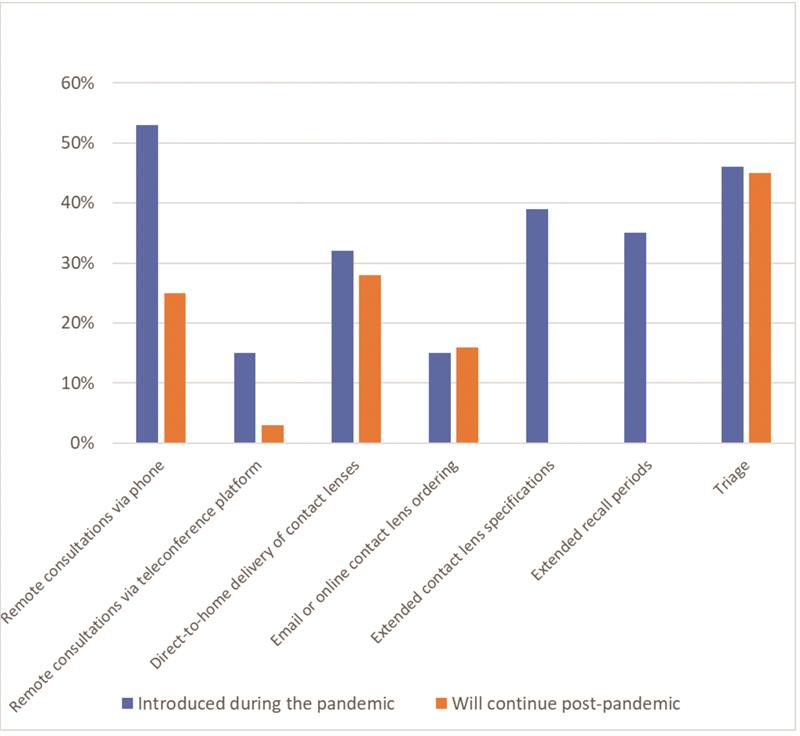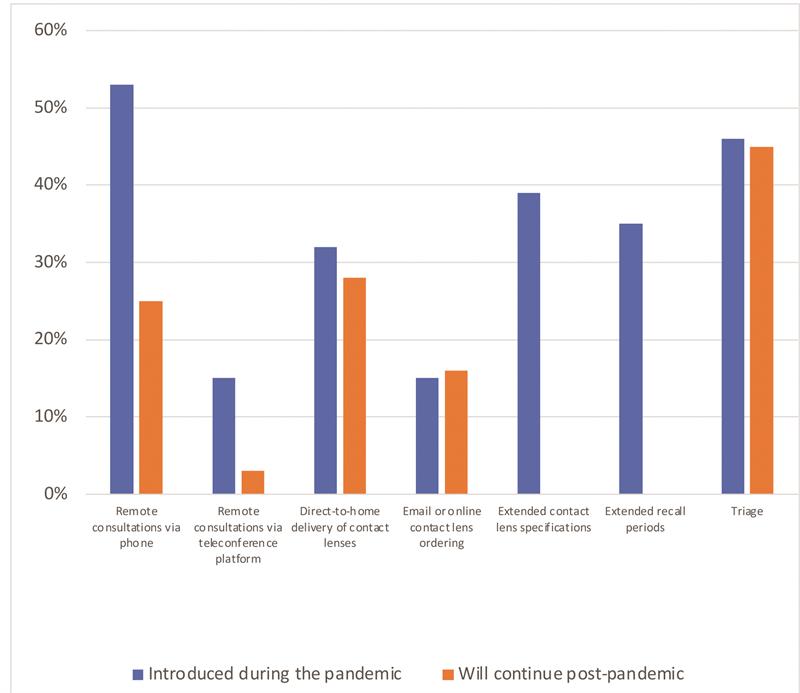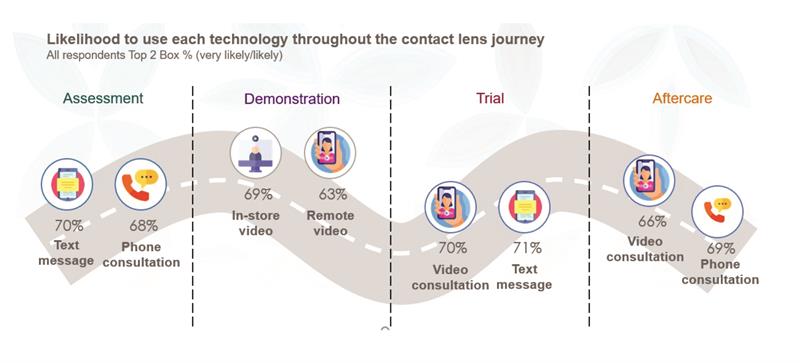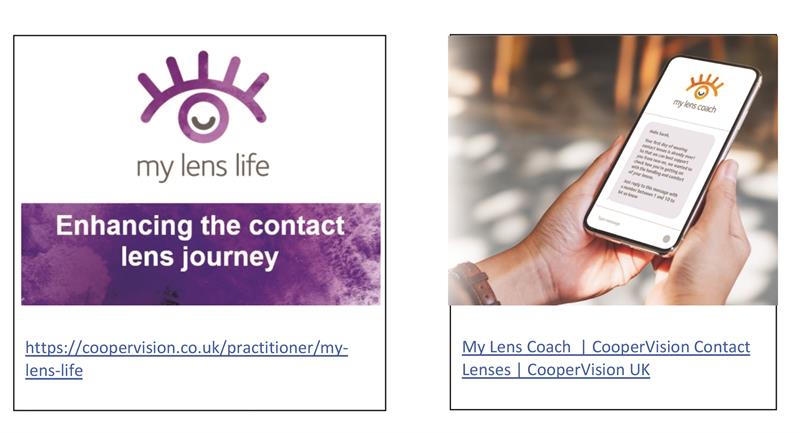Changing times
Contact lenses (CLs) and the Covid-19 pandemic; the interaction of these two subjects have been heavily discussed by the vision care industry over the past two years. From an optical industry point of view, it has been a convoluted journey, dealing with huge changes and interpreting guidelines and advice to help enable patients and staff to be kept safe from the virus, while continuing to provide essential optical services to communities. As part of the lockdown restrictions, an understanding of red, amber and green phases, introduced by the College of Optometrists, has been undertaken with practices adapting practically to accommodate ever-changing safety measures. Staff shortages, backlogs of patients and travel restrictions on public transport for commuting, have all been part of a daily concern for many. However, as the country emerges from the grip of the worst of the restrictions, it is vital to understand how public attitudes have changed, how practice processes have changed to accommodate this, and then to question, do the two align?
Firstly, considering the changes that were seen and experienced within the UK, it can be said that lives have changed inexorably compared to pre-pandemic times. During the pandemic, new hobbies were taken up, such as baking, growing vegetables, gardening, cycling and other sporting activities. One evolution that has touched almost everyone is the increased use and awareness of technology. During the lockdowns, there was a shift in reliance on a variety of communication technologies to interact with family and friends.1
There was a change in the way food and other household items were bought. Companies, such as delivery food suppliers and online retailers, who supplied wide ranges of products and services experienced a huge upsurge.2 Using digital communication technology became the norm with all ages becoming comfortable using apps, such as Skype and Zoom. This was referred to by a respondent from a UK 2021 independent qualitative survey by Verve when talking about how contact lens appointments were adapted:
“Before Covid-19, I’d never used Skype, I’d never used Zoom. I probably would have gone for a face-to-face appointment because that’s what I knew. But having got used to this over the last few months, I would use it if it were an option and we’re all well versed in it now.”1
Technology became more prevalent and accepted within the medical profession too. It had already been used pre-pandemic to a degree but gained momentum during the Covid-19 pandemic where general medical practitioner’s surgeries were using remote calls as a first response,3 only reverting to face-to-face meetings when necessary. Although very different at first, it is possible to reflect on how well patients accepted this as a way to be virtually ‘seen’ much sooner than the historic face-to-face appointments.
Technology has been acknowledged to provide more convenience.1 It is possible to buy what you want when you want and have it delivered. It promotes accessibility for those who struggle to go out shopping or reside in remote areas. Ordering items online provides a safer way of shopping, reducing the risk of infection from Covid-19, plus it is kinder on your purse and the environment by not having to travel to the shop.
According to Mintel Global Customer Trends 2021, there is a reference to consumers’ use of digital technology.4 However, focus areas were also shown to be wellbeing, coming together, value and experiences.4 When shopping, Mintel discussed how cashier-less stores, self-checkouts, home delivery and consolidated shopping trips will become the norm in the future reflecting interest by the consumer to be able to shop this way.4
With this information, it is worth inspecting optical practices to consider whether this desire is being currently fulfilled for patients.
To investigate this, CooperVision undertook a survey in partnership with Optometry Today in July 2021 to discover eye care practitioners’ (ECPs) viewpoints.5
Questions were asked relating to which new services and protocols had been introduced due to Covid-19, then followed up by which services they planned to continue beyond the pandemic. There were several interesting findings. Despite many practices being closed during lockdown, only 32% of ECPs offered direct-to-home delivery of CLs. Insightfully, the majority of ECPs who adopted direct-to-home delivery decided to continue with this service, indicating they had found this change in behaviour to be beneficial5 (see figure 1).
Figure 1: Which eye care protocols and services have been introduced during the Covid-19 pandemic and which of these shall be continued beyond the pandemic5

“I think that those who are vulnerable would be put off going to the opticians because they’re worried about infection. If technology would be available, I think it would definitely make it convenient for a lot of people, especially at the moment with the pandemic.”1
A further surprise, which might illustrate practices being at odds with patient’s general buying habits (between consumer goods and CLs as medical devices), included the low number of practices offering email or online ordering of CLs. Only 15% of practices introduced email or online CL ordering during the Covid-19 pandemic.5
Additional information is offered by other recent surveys,6, 7 which show there is a high preference for wearers to receive their lenses direct to their homes. More than two-thirds (69%) of patients agreed that ECPs should provide a service to deliver CLs to their house.6 Home delivery offers advantages for both practice and patient. Patients experience heightened convenience along with meeting their expectation of delivery as illustrated by a 2020 consumer survey,7 plus ECPs have less time-consuming ordering, organising and storing of CL products. There is also the advantage of reducing patient footfall into the practice to help reduce the potential spread of Covid-19.
Furthermore, using email, online ordering and subscription services, (providing the patient has an up-to-date CL prescription) provides the convenience of supply and expectation of customer service that patients demand.6, 7
Greater focus on health and freedom
Prior to the Covid-19 pandemic, studies showed that patients were interested in the health aspect of their CLs, with 97% of wearers finding a lens that is healthier for their eyes to be appealing.8 Insights from the Mintel 2021 study showed another key priority for consumers were that the pandemic has put health at the forefront of patient’s daily lives.4
As more people are prioritising health, there’s an opportunity to open up the CL health conversation with patients visiting the store more routinely.
As emergence from the lockdown developed, there was an indication of increased optimism, a drive towards new experiences and social events occurring once more. This was consistent with the Mintel report, which stated, Covid-19 revitalised the concept of community, with consumers craving human connection and interactions more than ever.4
To understand the relevance to practice, insights from research surveys into CL wearers can be considered. In a 2018 survey of 200 UK CL wearers, although practical applications of CLs were important, the over-riding, top ranking reasons for wearing CLs were freedom and self-confidence at 75% and 73%, respectively.8 This indicates that, despite practical applications, people think about how contact lenses makes them feel. This feeling of increased confidence was mirrored in the 2019 YouGov European study, which found that more than 80% of consumers agreed that wearing CLs make them feel confident,9 along with 79% stating that they feel more like themselves when wearing CLs9 compared to spectacles.
In an article from 2019, Draper and colleagues commented on how CL wearers experienced feeling a sense of freedom without restrictions, improved experiences when meeting friends and increased self-confidence.10 Significantly, nearly 90% of CL wearers stated that CLs have ‘improved their quality of life’.9 Of the 132 subjects that were considered ‘dual wearers’ of spectacles and CLs in a YouGov study, 81.1% felt that having the option of both forms of vision correction gave them the best of both worlds.8
When thinking about wearing CLs in comparison to wearing spectacles, more than 90% of consumers age 55+ agree that they feel attractive when wearing CLs, compared to reading spectacles when socialising with friends.11
Managing existing patients
The backlog of CL aftercares, the worry of unseen problems and the potential for CL drop out was a high concern for ECPs.5 ECPs have also considered the dilemma between providing new supplies of CLs when patients had not been seen recently, balanced with the concern of patients over-wearing lenses or moving to purchase unprescribed lenses online.
CL aftercare frequency was considered in the research of Professor Phillip Morgan and Professor Nathan Efron.12 Rather than following an aftercare frequency pattern, this paper, along with advice from governing optical bodies, recommends viewing each patient on an individual basis, considering factors such as: age, medical considerations, refractive status, CL modality and use.
Their publication discusses CL aftercare frequency alongside aspects such as the low incidence of microbial keratitis found with one day lens-wear and the advantages offered by certain CL materials (such as silicone hydrogels) to provide higher levels of oxygen transmissibility than hydrogels. They suggest certain factors negate the need to see patients in clinic as often as previously believed.12
This supports the argument for 24 months aftercare for one day lenses, which in turn enables combined appointments for both CL aftercare and sight test, allowing increased convenience for both patient and ECP. This also reduces practice touch points, aiding Covid-19 infection control (see table 1).
As previously alluded to, and in support of this recommendation, recent years have seen an update in advice and guidance issued by bodies, such as the Association of British Dispensing Opticians (ABDO), College of Optometrists and British Contact Lens Association (BCLA).13-15 Optical bodies and ECPs acknowledge that regular CL check-ups are still very important. ABDO comments: ‘Contact lens aftercare appointments are a vital part of a patient’s eye health regime. The frequency of these checks should be based purely on the ECP’s professional judgement of the patient’s clinical needs, the type of contact lens worn, the modality of wear and the practitioner’s structured judgement of the risk of adverse incidents.’13
Support could also be offered through the use of remote services, such as video calls, apps or phone triaging, should a patient need to be seen for a general check or issues that have arisen before their aftercare is due.
Despite these recommendations, less than 40% of ECPs plan to extend recall periods post-pandemic,5 according to the OT 2021 survey (see figure 2).
Figure 2: Processes and changes made during the Covid-19 pandemic by ECPs and intention to continue in the future5

The contradiction between wants and supplied service raises a couple of questions. Is this because ECPs are used to seeing these patients in clinic at these intervals due to historical practice and habit? And is it in the best interests of the patient?
Considering patient demands for fewer appointments and consolidated shopping trips, the survey results show a clear disparity with patient requests. From the 2021 survey,5 only a third of questioned ECPs are planning to continue offering combined eye examination and contact lens aftercare appointments, following its introduction during the Covid-19 pandemic. Yet, in a 2020 patient survey, 65% of new CL wearers would prefer combined appointments.1 With high proportions of separate appointments for CLs and eye examinations, ECPs bring into question the impact on time efficiency, patient preferences and risk of infection in practice.
Along the same thought process of reducing practice visits, it is evident that very few ECPs would continue to offer remote patient contact via telephone, video or tele-health platforms post-pandemic. However, those who did use this method of contact became advocates, stating: ‘Patients really appreciate it as long as it’s backed up by available face-to-face appointments where needed.’5
“For people like me that live a bit out of town, don’t drive and have a small child, it is useful to do things over the phone. I think this would be really helpful to people like me.”1
The most recent COO guidance states that patients are required to be seen face-to-face to complete CL specifications.14 This also includes aftercares/CL checks, where CL specifications are issued at the conclusion. But is there anything else that can be done differently? And, importantly, what specifically do patients want from ECPs regarding appointment types and support? Are there any ways in which increased familiarity with technology during the pandemic can help shape future ways of working?
Supporting new CL wearers
The Verve 2021 UK technology survey provided important learnings, including how different types of technology were appealing at different stages of the CL journey for patients1 (see figure 3).
Figure 3: Likelihood to use each technology throughout the CL journey (All respondents top two box % (very likely/likely))1

Beginning at the assessment stage, patients were very open to using text and phone to support their experience. This initial stage of the journey was shown to be where patients would have liked more information.1 Tools such as CooperVision’s My Lens Life16 (figure 4), which is dedicated to supporting new CL patients, may help prevent inaccurate information gathering when patients search online for information to support their lens wear experience or seek further advice.
At the demonstration or teaching stage, almost half of all new CL patients stated that they would have liked more information and support. However, they were also open to having the demonstration or teaching stage supported via in-store and remote video.1 This enables the opportunity to send instructional videos pre-lens fit to prepare the patient. To reduce face-to-face contact time with a staff member on a one-to-one basis in store, a video instructor may be used with check-ins provided by the support staff. Anecdotal evidence suggests that the response has been very positive as this approach has reduced the time taken for demonstrations in practice, along with the increased confidence and ability of patients.
Figure 4: My Lens Life and My Lens Coach tools (from CooperVision) to help support new contact lens wearers

At the trial stage, where the patient takes the lenses away, survey participants showed high likelihood to use phone, or video consultation along with text to support.1 Patients were happy to have their CL fitting follow up as a remote appointment. Further support offered by a text service, such as CooperVision’s My Lens Coach17 (figure 4), had high appeal shown by the BCLA 2021 paper presentation and has demonstrated the ability to help reduce the risk of drop out from CLs at this crucial stage.19
Further information from the Verve 2020 survey suggested that patients displayed a reluctance to instigate a call for help, with study participants describing how they blame themselves for not being able to use the CLs and feel embarrassed.1
Saying: “It was so daunting . I thought they’d think I was silly. I was really nervous, what if I do it wrong? Putting [CLs] in was so stressful, without someone watching.”1
Anecdotal evidence from multiple practices suggests that having support via a phone call or text service could help remove that concern and enable ECPs to not only offer a superb service to their patients, but also to help minimise potential drop out in the early days.
“It would have been nice if someone had phoned me up – I didn’t like having to initiate the contact.”1
Discussion
Communication technology and CL technology marches on at an astounding pace with ground-breaking innovations to enhance our lives. Businesses of all descriptions are evolving to cope with new demands and priorities following the Covid-19 pandemic and the optical industry has the tools to match the changes demanded by our patients. The time may have come to update ways of working and plot out a smarter, leaner, patient-friendly process to support new wearers as they become experienced CL users, and retain existing wearers in a way which they wish to be served.
- Samantha Armstrong is a contact lens optician. She has worked in practice for a number of years with responsibilities for portfolio management, practice management and senior contact lens support. She also holds a post-graduate degree in teaching, is a fellow of the BCLA and an active member of the BCLA education panel. She is currently professional services consultant for UK& Ireland at CooperVision.
Acknowledgement
This article is supported by CooperVision.
References
- CVI data on file. Technology in the contact lens journey UK, Verve, November 2020. N=2064 UK new and lapsed contact lens wearers
- https://osome.com/uk/blog/2021-ecommerce-trends/ accessed 1/2/22
- https://www.england.nhs.uk/2020/05/millions-of-pat... accessed 1/2/22
- Mintel Global Customer Trends 2021 https://www.mintel.com/ accessed 15/9/21
- CVI data on file 2021. AOP OT Online Insight Research Survey July ‘21 : COVID-19 and Optometric Practice; N=589 UK ECPs
- CVI data on file 2021. Covid-19 contact lens users survey, CL EMEA, Verve, 2021 GB adults who were new or lapsed CL wearers n=2064
- CVI data on file 2020. COVID-19 contact lens users survey, Verve, April & May 2020. Base (all respondents): Total UK n = 480
- CVI data on file. CooperVision consumer insight study, July 2018. GB adults who wear daily disposable contact lenses: n=279
- CVI data on file 2020. YouGov Plc online consumer survey Nov/Dec 2019 in Germany, UK, Spain, Japan, USA. N=5,117 Contact Lens wearers (“consumers”), screened from total N=35,397 adults. Data weighted and representative of adults in each market (aged 18+).”
- Draper M, Patel K, Russell N. Mixed-methods study of behaviours and attitudes to vision correction of spectacle and contact lens wearers. Contact Lens and Anterior Eye 2019;42:e23.
- CVI data on file, 2020. YouGov Plc online consumer survey Nov/Dec 2019 in Germany, UK, Spain, Japan, USA. N=5,347 Contact Lens wearers
- Efron, N and Morgan, PB. 2017. Rethinking contact lens aftercare. Clinical and Experimental Optometry. 100. Pp. 411-431
- https://www.abdo.org.uk/about-us/media-centre/press-release-abdo-updates-guidance-on-contact-lens-aftercare- frequency accessed 10/1/22
- https://www.college-optometrists.org/clinical-guid... accessed 26/1/22
- https://bcla.org.uk/common/Uploaded%20files/CLEAR/... accessed 26/1/22
- https://coopervision.co.uk/practitioner/my-lens-li... accessed 26/1/22
- https://coopervision.co.uk/practitioner/my-lens-co... accessed 26/1/22
- CVI Data on file, 2016 Contact lens category retention white paper
- Patel K. The impact on new CL wearer retention after introduction of a patient support tool. BCLA Conference Paper Presentation June
